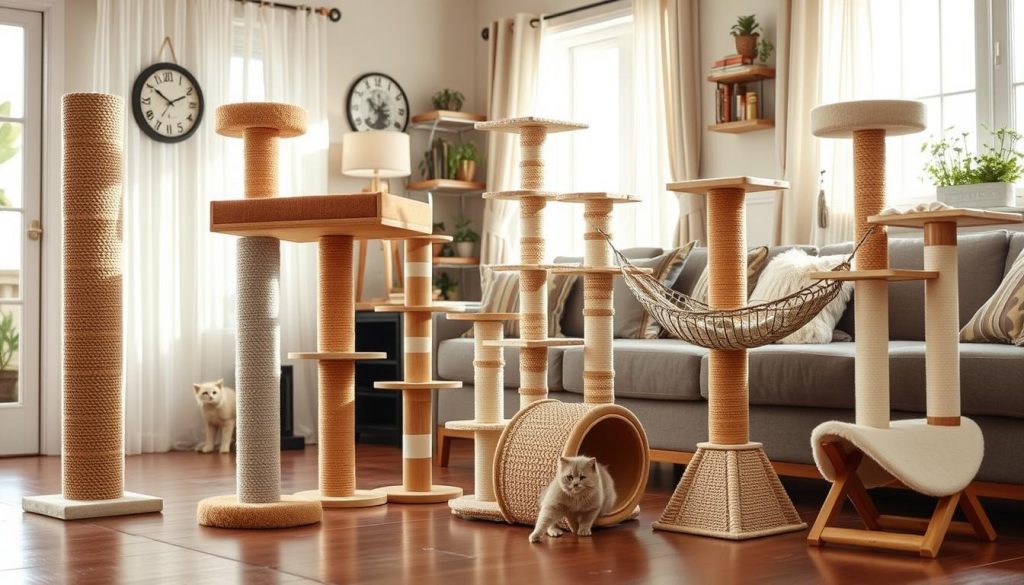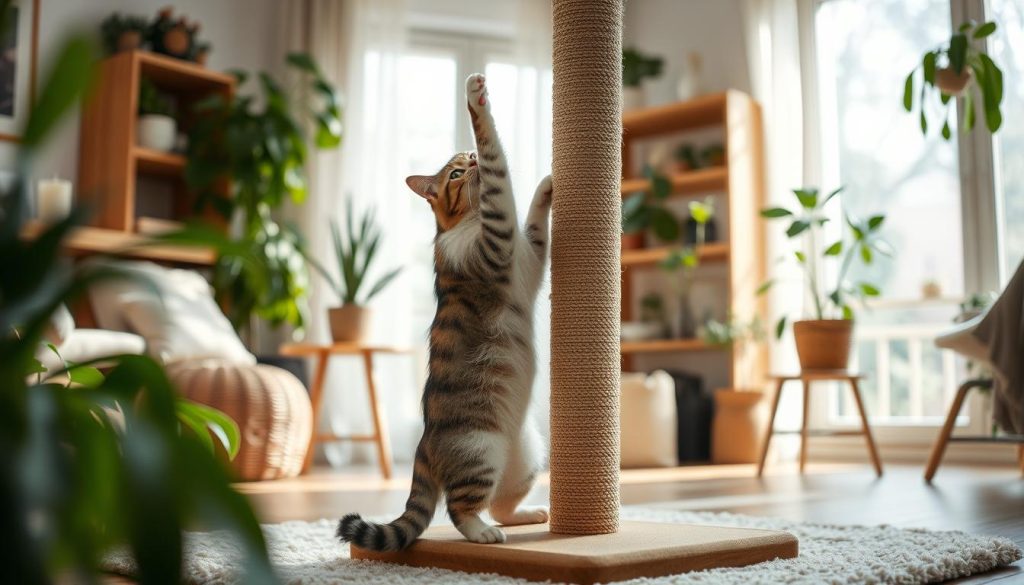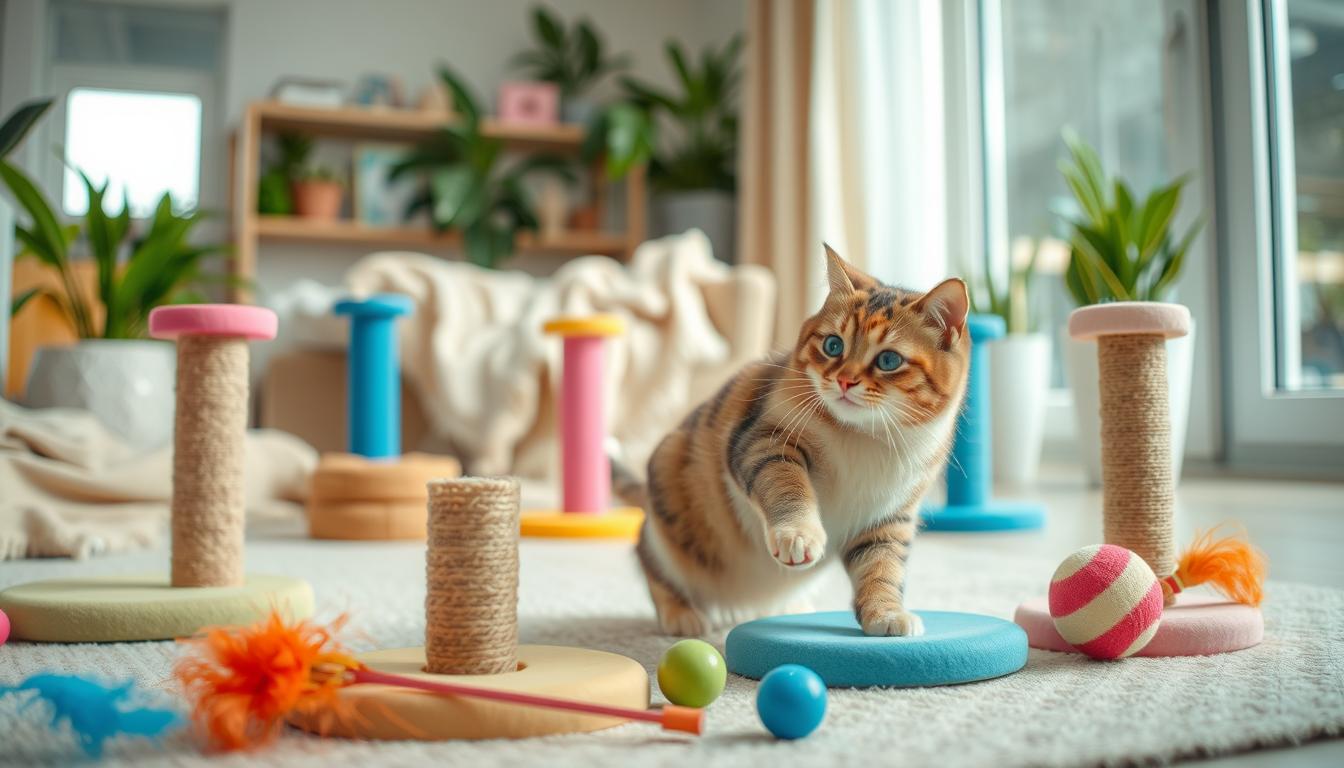As a cat parent, I know the struggle of protecting your home from your feline friend’s natural scratching behavior. Declawing may seem like a quick solution, but it can harm your cat physically and emotionally. In this article, I’ll explore humane alternatives to cat declawing that focus on your cat’s well-being and protect your home. You’ll discover paw-sitive options that will make you and your furry friend happy.
Declawing your cat might seem like a way to prevent furniture damage. But, it’s a procedure with big risks. Instead, I’ll show you cat declawing alternatives that are humane and work well. You’ll learn about scratching posts and nail trimmings that meet your needs and your cat’s instincts.
Choose paw-sitive options to create a harmonious home for you and your cat. Say goodbye to worries about furniture protection for cats. Welcome a stress-free, cat-friendly space that makes everyone happy.
Understanding the Harmful Effects of Cat Declawing
As pet owners, we want to protect our homes from our cat’s sharp claws. But declawing, or onychectomy, is seen as inhumane. It can harm our beloved cats greatly. The cat declawing dangers and the physical and emotional impact of cat declawing are key for every pet owner to know.
Why Declawing is Inhumane
Declawing is more than just cutting a cat’s nails. It’s amputating the last bone of each toe. This surgery hurts a lot and can cause long-term problems like arthritis and behavioral issues. It also makes cats more likely to bite.
The Physical and Emotional Impact on Cats
The physical impact of cat declawing is harsh. Cats may feel chronic pain, have trouble walking, and face a higher risk of arthritis. The emotional damage is just as bad. Declawed cats can become anxious, aggressive, or withdrawn, missing their natural defense.
Deciding to declaw a cat is a big choice. Pet owners should think carefully about the dangers of cat declawing. They should look for kinder ways to protect their homes and their cat’s health.
Cat declawing alternatives: Prioritizing Your Feline Friend’s Well-being
As a cat owner, I know you want to protect your home from scratches. But declawing is not the right choice. There are many humane ways to keep your furniture safe without harming your cat.
One great option is to get high-quality scratching posts and pads. These give your cat a place to scratch, keeping their paws and claws healthy. It also saves your furniture from damage.
Another good choice is nail caps. They’re a temporary fix that covers your cat’s claws without hurting them. You can easily put them on and replace them as your cat’s nails grow. It’s a safe way to protect your furniture.
| Humane Alternative | Benefit |
|---|---|
| Scratching Posts and Pads | Provides an appropriate outlet for scratching, preserves natural behavior |
| Nail Caps | Temporary solution, covers claws without affecting scratching ability |
| Trimming Nails | Maintains nail length, reduces damage to furniture |
Also, trimming your cat’s nails regularly is a gentle way to keep them short. This helps prevent damage to your furniture. By doing this, you can keep your home safe without hurting your cat.

Remember, finding a balance is key to a happy home. By choosing humane alternatives to declawing, you can make sure your cat is happy and your home is safe.
Effective Scratching Solutions for Your Home
As a cat owner, you know how important it is to give your cat places to scratch. Cat scratching posts protect your furniture and let your cat scratch naturally. They help keep your cat’s claws healthy. By choosing the right scratching solutions, you can keep your home looking great and meet your cat’s needs.
Types of Scratching Posts and Their Benefits
Cat scratching posts come in many materials, sizes, and designs. Each type has its own benefits for your cat’s health. Let’s look at some of the most popular ones:
- Vertical Scratching Posts – These tall posts, often made of sisal or corrugated cardboard, let cats stretch and scratch naturally. They keep claws sharp.
- Horizontal Scratching Pads – These flat pads are great for cats who like to scratch while lying down. They can be on the floor or on walls to save space.
- Scratching Towers – These have both vertical and horizontal surfaces. They offer cats many scratching options and can have platforms for resting and playing.
- Catnip-Infused Scratchers – These scratchers have natural catnip. It makes them more appealing to your cat, encouraging them to use their scratching areas.
By placing different types of cat scratching posts around your home, you can meet your cat’s scratching needs. This helps protect your furniture from scratches.

Training Your Cat to Scratch Appropriately
Scratching is a natural behavior for cats. It’s important to give them the right places to scratch. This way, you can save your furniture and let your cat scratch naturally.
Positive reinforcement is a great way to train your cat. Give them treats or praise when they scratch the right spots. This makes them want to scratch there more.
- Find out where your cat likes to scratch and put scratching posts or pads there.
- Use catnip or a laser pointer to get them to scratch the right spots.
- Always praise and reward your cat when they scratch where they should.
You can also gently redirect your cat if they scratch where they shouldn’t. If you see them scratching furniture, guide them to a scratching post or pad. Then, reward them for using it.
| Positive Reinforcement Techniques | Redirection Strategies |
|---|---|
|
|
Using positive reinforcement and redirection together can train your cat to scratch where they should. This keeps your home safe and lets your cat scratch naturally.

Trimming Your Cat’s Nails: A Gentle Approach
Trimming your cat’s nails is key to keeping your home safe and your cat’s paws healthy. It might seem scary, but with the right steps, it can be easy and safe for both you and your cat. Here’s a simple guide to help you trim your cat’s nails gently and effectively.
Step-by-Step Guide to Safe Nail Trimming
Keeping your cat’s nails in check is easy with the right tools and a little patience. Follow these steps for a stress-free nail trimming session:
- Gather the necessary supplies: high-quality cat nail clippers, styptic powder (to stop any bleeding), and cat treats.
- Familiarize your cat with the nail trimming process by gently handling their paws and rewarding them with treats. This will help them feel more comfortable during the actual trimming.
- Ensure your cat is relaxed and calm before starting. You may want to try trimming their nails after playtime or when they’re napping.
- Gently press on your cat’s paw to extend their nail, then carefully trim the clear, sharp tip, avoiding the pink quick (the blood vessel inside the nail).
- If you accidentally cut the quick, apply a small amount of styptic powder to stop any bleeding. Comfort your cat and offer a treat to reassure them.
- Reward your cat with praise and treats after a successful nail trimming session to reinforce the positive experience.
By following these safe and gentle steps, you can help keep your cat’s nails trimmed without causing them undue stress or discomfort. Remember, regular nail trims are essential for your cat’s overall health and well-being.
Feline-Friendly Home Modifications
Making your home comfortable for your cat is key to stop unwanted scratching and protect your furniture. I’ll share tips to make your home cat-friendly and keep your furniture safe.
Creating a Scratching-Friendly Environment
Offering your cat different scratching surfaces is crucial. Place scratching posts, pads, and mats in spots your cat likes. This could be near where they sleep or where they enter your home.
Using cat-safe deterrents like sticky tape or citrus scents on furniture can also help. These will gently keep your cat away from certain areas while letting them scratch where they should.
By making your home cat-friendly and providing scratching options, you can keep your cat happy and your home safe.

